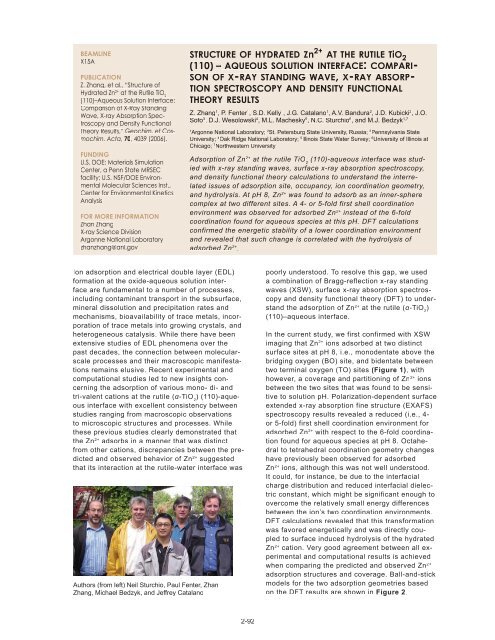NSLS Activity Report 2006 - Brookhaven National Laboratory
NSLS Activity Report 2006 - Brookhaven National Laboratory
NSLS Activity Report 2006 - Brookhaven National Laboratory
You also want an ePaper? Increase the reach of your titles
YUMPU automatically turns print PDFs into web optimized ePapers that Google loves.
BEAMLINE<br />
X15A<br />
PUBLICATION<br />
Z. Zhang, et al., “Structure of<br />
Hydrated Zn 2+ at the Rutile TiO 2<br />
(110)–Aqueous Solution Interface:<br />
Comparison of X-Ray Standing<br />
Wave, X-ray Absorption Spectroscopy<br />
and Density Functional<br />
Theory Results,” Geochim. et Cosmochim.<br />
Acta, 70, 4039 (<strong>2006</strong>).<br />
FUNDING<br />
U.S. DOE; Materials Simulation<br />
Center, a Penn State MRSEC<br />
facility; U.S. NSF/DOE Environmental<br />
Molecular Sciences Inst.,<br />
Center for Environmental Kinetics<br />
Analysis<br />
FOR MORE INFORMATION<br />
Zhan Zhang<br />
X-ray Science Division<br />
Argonne <strong>National</strong> <strong>Laboratory</strong><br />
zhanzhang@anl.gov<br />
Ion adsorption and electrical double layer (EDL)<br />
formation at the oxide-aqueous solution interface<br />
are fundamental to a number of processes,<br />
including contaminant transport in the subsurface,<br />
mineral dissolution and precipitation rates and<br />
mechanisms, bioavailability of trace metals, incorporation<br />
of trace metals into growing crystals, and<br />
heterogeneous catalysis. While there have been<br />
extensive studies of EDL phenomena over the<br />
past decades, the connection between molecularscale<br />
processes and their macroscopic manifestations<br />
remains elusive. Recent experimental and<br />
computational studies led to new insights concerning<br />
the adsorption of various mono- di- and<br />
tri-valent cations at the rutile (α-TiO 2 ) (110)-aqueous<br />
interface with excellent consistency between<br />
studies ranging from macroscopic observations<br />
to microscopic structures and processes. While<br />
these previous studies clearly demonstrated that<br />
the Zn 2+ adsorbs in a manner that was distinct<br />
from other cations, discrepancies between the predicted<br />
and observed behavior of Zn 2+ suggested<br />
that its interaction at the rutile-water interface was<br />
Authors (from left) Neil Sturchio, Paul Fenter, Zhan<br />
Zhang, Michael Bedzyk, and Jeffrey Catalano<br />
STRUCTURE OF HYDRATED Zn 2+ AT THE RUTILE TiO2 (110) – AQUEOUS SOLUTION INTERFACE: COMPARI-<br />
SON OF X-RAY STANDING WAVE, X-RAY ABSORP-<br />
TION SPECTROSCOPY AND DENSITY FUNCTIONAL<br />
THEORY RESULTS<br />
Z. Zhang 1 , P. Fenter 1 , S.D. Kelly 1 , J.G. Catalano 1 , A.V. Bandura 2 , J.D. Kubicki 2 , J.O.<br />
Sofo 3 , D.J. Wesolowski 4 , M.L. Machesky 5 , N.C. Sturchio 6 , and M.J. Bedzyk 1,7<br />
1 Argonne <strong>National</strong> <strong>Laboratory</strong>; 2 St. Petersburg State University, Russia; 3 Pennsylvania State<br />
University; 4 Oak Ridge <strong>National</strong> <strong>Laboratory</strong>; 5 Illinois State Water Survey; 6 University of Illinois at<br />
Chicago; 7 Northwestern University<br />
Adsorption of Zn 2+ at the rutile TiO 2 (110)-aqueous interface was studied<br />
with x-ray standing waves, surface x-ray absorption spectroscopy,<br />
and density functional theory calculations to understand the interrelated<br />
issues of adsorption site, occupancy, ion coordination geometry,<br />
and hydrolysis. At pH 8, Zn 2+ was found to adsorb as an inner-sphere<br />
complex at two different sites. A 4- or 5-fold first shell coordination<br />
environment was observed for adsorbed Zn 2+ instead of the 6-fold<br />
coordination found for aqueous species at this pH. DFT calculations<br />
confirmed the energetic stability of a lower coordination environment<br />
and revealed that such change is correlated with the hydrolysis of<br />
adsorbed Zn 2+ .<br />
2-92<br />
poorly understood. To resolve this gap, we used<br />
a combination of Bragg-reflection x-ray standing<br />
waves (XSW), surface x-ray absorption spectroscopy<br />
and density functional theory (DFT) to understand<br />
the adsorption of Zn 2+ at the rutile (α-TiO 2 )<br />
(110)–aqueous interface.<br />
In the current study, we first confirmed with XSW<br />
imaging that Zn 2+ ions adsorbed at two distinct<br />
surface sites at pH 8, i.e., monodentate above the<br />
bridging oxygen (BO) site, and bidentate between<br />
two terminal oxygen (TO) sites (Figure 1), with<br />
however, a coverage and partitioning of Zn 2+ ions<br />
between the two sites that was found to be sensitive<br />
to solution pH. Polarization-dependent surface<br />
extended x-ray absorption fine structure (EXAFS)<br />
spectroscopy results revealed a reduced (i.e., 4-<br />
or 5-fold) first shell coordination environment for<br />
adsorbed Zn 2+ with respect to the 6-fold coordination<br />
found for aqueous species at pH 8. Octahedral<br />
to tetrahedral coordination geometry changes<br />
have previously been observed for adsorbed<br />
Zn 2+ ions, although this was not well understood.<br />
It could, for instance, be due to the interfacial<br />
charge distribution and reduced interfacial dielectric<br />
constant, which might be significant enough to<br />
overcome the relatively small energy differences<br />
between the ion’s two coordination environments.<br />
DFT calculations revealed that this transformation<br />
was favored energetically and was directly coupled<br />
to surface induced hydrolysis of the hydrated<br />
Zn 2+ cation. Very good agreement between all experimental<br />
and computational results is achieved<br />
when comparing the predicted and observed Zn 2+<br />
adsorption structures and coverage. Ball-and-stick<br />
models for the two adsorption geometries based<br />
on the DFT results are shown in Figure 2.

















